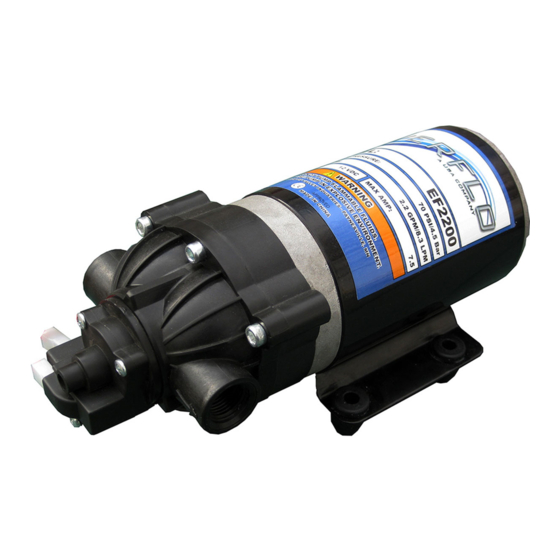
Table of Contents
Advertisement
Instructions for Assembly, Testing, Operation, Servicing, and Storage
12V Diaphragm Pump: For use with agricultural pesticides and other
READ and UNDERSTAND the Owner's Manual completely before using this
pump. Assemble, test, and use only in accordance with the Owner's Manual
instructions.
READ and FOLLOW chemical safety instructions. Pesticides are hazardous
chemicals.
KNOW emergency procedures BEFORE handling chemicals. Pump leaks, bodily
chemical contact, poisoning, and spills require immediate response.
AVOID inhaling, ingesting, or coming into contact with any chemicals.
WEAR personal protective gear when operating, cleaning, and servicing the
pump.
KEEP pump and spray materials away from children and pets. Pesticides are
especially toxic to them.
DO NOT TURN ON POWER to pump until ready to spray in order to avoid
unintentional spray release.
Improper use of the pump or handling of chemicals could result in serious
injury or illness to the operator or nearby persons/animals, or could cause
damage to the environment.
** This pump is recommended for use in spraying non-flammable liquids such as pesticides, water
for plants/trees or dust control, ice control chemicals, or water-based non-flammable sealants or
stains for outdoor wood surfaces. However, WE RECOMMEND THAT THE PUMP NOT BE
USED FOR OTHER PURPOSES ONCE IT HAS BEEN USED FOR SPRAYING PESTICIDES.
Any chemical will leave some residual in the pump, even after the pump has been properly cleaned.
These residual chemicals can have unexpected effects on future uses. For example, spraying water
or other liquids that are contaminated with residual pesticide may result in unforeseen hazards to
plant or animal life.
Any Questions, Comments, Problems, or Parts Orders
Call EverFlo Product Support 1-800-864-1649
Owner's Manual
liquids**
WARNING
ITEM NUMBERS:
EF1000
EF2200
EF2200-QA
EF3000
EF3000-QA
EF4000
EF4000-QA
EF5500
EF5500-QA
(Includes Boxed Models)
SERIAL NUMBER: __________
1.0 GPM
2.2 GPM
2.2 GPM
3.0 GPM
3.0 GPM
4.0 GPM
4.0 GPM
5.5 GPM
5.5 GPM
Advertisement
Table of Contents

Summarization of Contents
Chemical Accident Procedures
Pump Leak Procedures
Procedure for handling pump leaks and stopping spraying.
Bodily Chemical Contact Procedures
Personal contamination procedures including first aid and seeking medical advice.
Poisoning by Ingestion or Inhalation
Emergency response for poisoning via ingestion or inhalation, including calling emergency services.
Chemical Spill Response
Steps for containing and cleaning chemical spills, including manufacturer and agency contacts.
Installation - Step One: Mounting
Mounting Guidelines
Instructions for mounting the EverFlo pump, emphasizing ventilation and motor placement.
Installation - Step Two: Plumbing
Plumbing Guidelines
Guidance on connecting hoses and fittings, including port sizes and material recommendations.
Step Three: Connect pump to battery or 12V supply
Preparatory Safety Steps
Essential safety precautions before connecting the pump to a battery, including eye protection.
CE Requirements
Information on circuit requirements for CE compliance, including fuse and wire size specifications.
Step Four: Check and test completed assembly
Assembly Check and Testing
Instructions for verifying the pump assembly is correct and safe before operation.
Operation – Important Safety Information
General Chemical Safety
Key safety guidelines for handling hazardous chemicals, including label instructions and PPE.
Chemical Application Safety
Before Spraying Procedures
Preparation steps before spraying, including pump inspection and power management.
During Spraying Procedures
Safety practices during spraying, such as avoiding over-application and protecting from heat.
After Spraying Procedures
Procedures for cleaning the pump and personal decontamination after use.
Operation – Preparing the Pump for Each Use
Ensure Clean System
Ensure pump is thoroughly flushed and drained of residual chemicals from prior uses.
Inspect and Repair
Inspect hoses, lines, and fittings for damage; test with water after repairs.
Operation – Using the Pump
Step One: Assess Wind Conditions and Clear Work Area
Determine suitability of wind conditions and clear the work area of people and pets.
Step Two: Operate the Pump
Wear PPE, review safety info, and turn on the pump as instructed.
Pump Operation Details
Pressure Switch Operation
Explanation of how the pressure switch reacts to outlet pressure and interrupts power.
Leaving Unattended Procedures
Steps to take if the pump must be left unattended during operation.
Discontinue Use if Clogged or Inoperative
Instructions for when to stop using the pump if it becomes clogged or inoperative.
Operation – Clean Pump and Decontaminate After Use
Drain Pump System
Procedure for draining excess pesticide from the pump system into a suitable container.
Unused Chemical Handling
Guidelines for storing or disposing of unused pesticide and its container.
Flush Pump Procedures
General procedure for flushing the pump with water and cleaning solution.
Personal Decontamination and Laundering
Steps for decontaminating yourself and laundering clothing after handling chemicals.
Storage
Preparing for Storage
Steps to prepare the pump for end-of-season storage, including adding antifreeze.
Removing from Storage
Procedures for preparing the pump for use after storage, including draining and flushing antifreeze.
Troubleshooting
Service Preparation and Safety
Includes PPE, emptying/flushing, disconnecting power, and relieving pressure before servicing.
Troubleshooting Steps and Repairs
Reviewing the table, performing repairs, and testing after servicing.





Need help?
Do you have a question about the EF2200-QA and is the answer not in the manual?
Questions and answers